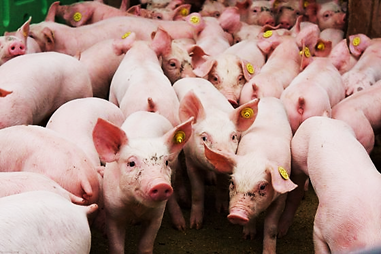Avian influenza outbreaks still constantly happen in the neighboring countries of Viet Nam such as China, Laos and Cambodia (WHO). In the year 2015, China has 226 more cases of A/H7N9 positive, which results in 94 deaths. In Viet Nam, Avian influenza is having a high risk of an outbreak. According to the General Department of Preventive Medicine (Ministry of Health), in the coming times of before and after the Lunar New Year holiday, which has suitable weather for the spread of influenza virus plus a large traffic rate between borders of traders and tourists as well as the very high demand of poultry products, all of which culminates in a huge impact on the chance of outbreaks.
To help farmers and readers get an in-deep understanding of Avian influenza as well as ways to respond to the disease and protect the flocks, Vemedim Corporation is pleased to introduce an article about Avian influenza.
Avian influenza or bird flu is a type of infectious viral disease in birds and sometimes mammals. The virus was first discovered in Italia around the first years of 1900, since then it has spread all over the globe. It was named Avian influenza (AI) A and belongs to the Orthomyxoviridae family. The family is a retrovirus, which carries its genetic material in RNA (ribonucleic acid). The H5N1 subtype of Avian influenza has started to afflict the world since 1997, it holds the potential of becoming a pandemic in the future.

Scientists all over the world are pouring their resources to research more on Aviva influenza and its threat to the population in order to enable more effective preventative methods and find suitable directions for future poultry farming.
Avian influenza A and its subtype H5N1:
Avian influenza belongs to the family Orthomyxoviridae, which is classified into 3 types of A, B, and C by the organization of their nucleoprotein and matrix protein antigens. Avian influenza A virus can infect vertebrates such as birds, humans, and other mammals.
Influenza A viruses are further classified based on the viral surface proteins hemagglutinin (H) which acts as a binder to help the virus attaches to cells and neuraminidase (N) which is responsible for helping the virus to elute the virion progeny from the infected cell and assist in the mobility of virus particles through the respiratory tract mucus. There are 16 types of H and 9 types of N, which combines into 144 subtypes of Avian influenza A. In addition, every subtype has 2 groups of lowly pathogenic avian influenza (LPAI) and highly pathogenic avian influenza (HPAI).
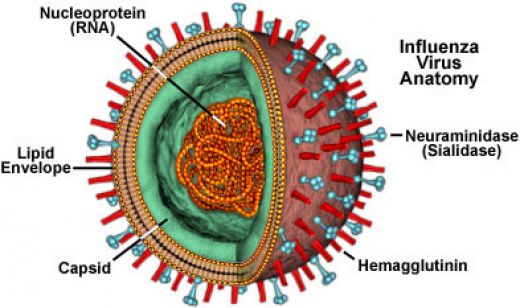
The current outbreak of the AI virus belongs to the subtype H5N1, group HPAI, they have a tendency to attach to an α-2,3 sialic acid receptor in poultry cells located in the respiratory and digestive tract. (for humans, the α- 2,6 sialic acid receptor is located on the upper respiratory tract). This information indicates that H5N1 is more likely to infect poultry than humans.
Recent researches show that humans also have α- 2,3 sialic acid receptor so they can be infected by H5N1, although because these receptors are located deep within the lungs so it’s very difficult for the virus to bind to them, and should they succeed, they still struggle to escape from the cell after replication and find other cells to infect.
Subtype H1N1:
Subtype H1N1 is the first AI subtype that was isolated. In October 2015, the virus that caused the Spanish flu pandemic was successfully restored by scientists. The following gene sequencing showed that the AI virus subtype H1N1 was responsible for the pandemic.
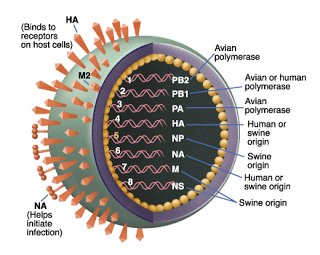
In March and April of 2009, an outbreak caused by a new type of H1N1 virus swept through the population and infects 2.000 people with several deaths. WHO reports that up to 6/5/2009 there are 1.893 cases through 23 countries, mainly in Mexico and 31 deaths (27 in Mexico, 2 in the United States). In Viet Nam, there are 36 deaths because of AI subtype H1N1 (30/10/2009).
As such, there are two types of AI in Viet Nam: H5N1 and H1N1. There is a chance that they will recombine into a new type that has a higher pathogenic ability in the upcoming months with a suitable environment of low temperature.
Way of transmission:
The AI virus is found in the secretion of the respiratory tract and in the feces of infected poultry. One gram of feces can infect one million chickens. The transmission rate through physical contact is very high. In addition, like another viral transmissible disease, the AI virus can transmit indirectly through air, food, water, clothes, equipment, on the leg and body of rodents…
Some types of AI viruses can infect animals such as birds, pigs, horses, seals, whales, tigers, and humans. AI not only spreads by air but also by food, water, equipment, and clothes.
The role of migration in spreading the disease is very important. The H5N1 virus was carried by birds from China and South East Asia countries to other continents, causing tens of millions of poultry deaths and 138 human deaths from 12/2003 to 8/2006. Most of the deaths are from Asia where people have close contact with poultry due to farming methods and culture.
Symptoms:
The symptoms depend on the infected host.
– Chicken: the incubation period is from a few hours to 3 days, infected chicken has sepsis, respiratory tract inflammation, organic and hypodermic hemorrhage. Infected chicken dies very quickly within 48 hours of infection and the mortality rate is as high as 90%. Within 3-4 days of infection, the whole flock may die. Typical symptoms include ruffle feathers, diarrhea and wheezing. Neurological symptoms such as paralysis and loss of direction occur just before dying. Post-mortem shows red induration of the lungs, swelling spleen, hemorrhage in the digestive tracts such as gizzard, proventriculus and intestine. Hemorrhage at the legs, swelling of the head, eyelids, comb, wattles and hocks can also be observed.
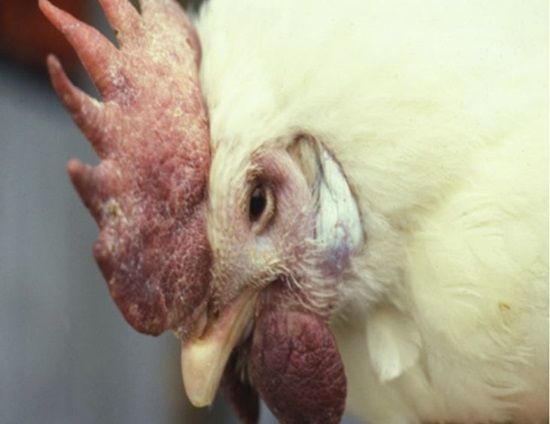

Post-mortem signs of hemorrhage in the proventriculus and gizzard are very easy to misaddress with Newcastle disease. Swelling at the liver as well as dots of necrosis are easy to misaddress with hemorrhagic septicemia.
– Duck: symptoms are not as clear as in chicken, most of infected ducks die suddenly with neurological symptoms, convulsion. Post mortem signs include slight eyelid swell and hemorrhage of organ is very similar to duck viral enteritis.
– Other poultry (bird, geese, quails): the only symptoms are lack of energy, sudden death and high mortality rate.
Pandemic alarm:
From the aftermath of 50 million deaths in the flu pandemic in 1918, scientists warn that if H5N1 mutates to be able to infect humans, it will create a pandemic that can kill hundreds of millions worldwide. H5N1 can mutate easier because it has ARN as genetic material.
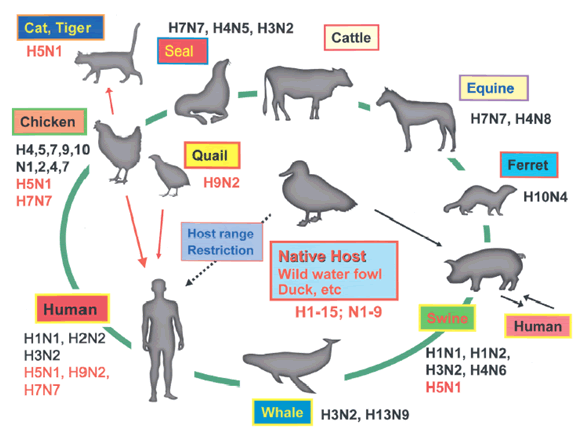
Furthermore, the farming method that had farmers and livestock in close contact in China, Thailand, Viet Nam… is convenient for H5N1 to mutate.
Pigs have two receptors of α-2,3 sialic acid and α-2,6 sialic acid so they are susceptible to both flu virus on poultry and human. So the chance of recombination when both types of virus present in a single cell can happen and a new type of flu virus that can infect humans may emerge and cause a pandemic with hundreds of millions deaths.
However, there are views that a pandemic of that magnitude is not likely to happen because of medical advancement since the pandemic of 1918. Nowadays we can control the virus viva disinfection of outbreak locations, removing infected poultry and carrying out vaccine programs to prevent spreading. On the other hand, there are medications that can effectively treat flu such as Tamiflu (oseltamivir) or Relenza (zanamivir) on humans and in experimental medicine Hypericin (extract of Hyperycum perforatum L) on poultry. Besides, if a H5N1 pandemic occurs, many nations can quickly contact each other and develop a response very fast due to high-speed communication.
Preventing the disease:
AI can not only infect poultry but also humans, causing a huge impact on socio-economic development. To gain high efficiency in preventing the disease, multiple methods should be combined:
* On poultry:
– Renovate farming method: farms should have some distance with living area, apply new procedure such as all in, all out to prevent the spreading of disease. Vaccine programs should be implemented in poultry farming.
– Control slaughtering phase: slaughterhouse should monitor the origin and state of the outbreak for each batch of animals. Use automatic ways of slaughter and packaging.
– Do not sell live animals at the market and living area.
– Use vaccine H5N1 for chickens and ducks: 0.3ml/each for 2-5 week-old, 0.5ml/each for over 5 week-old. Repeat after 4 months. For duck use, 0.5ml/each for 2-5 week-old, repeat after 28 days 1ml/each and one more time after 4 months.
– Vaccine AI for other poultry and mammals is not yet available. In order to prevent AI, they should not be raised together with chickens and ducks as well as using the biological and nutritional preventive methods, disinfection. Dr. Frank W. Edens (2006) has proven that there is a relationship between Selenium and AI. He points out that the lack of Selenium will make AI more severe as well as the virus is more likely to mutate. Edens’ research shows that Selenium supplement in the feed will decrease the chance of mutation of H5N1.
– Disinfection: disinfect twice a week with common drugs belong to the aldehyde group (formol, glutaraldehyde), phenol, iodine, oxidize substances (sodium dodecyl sulfate) on clothes, farming equipment and vehicles. Note: before using disinfection, the farm should be cleaned first because many of them will have decrease effectiveness when in contact with organic material (Chlorine, Chloramin B, Chloramin T, Iodine); there are disinfections that have low effectiveness against AI (BCK), they should only be used at disease-free zone.


– Check for the flock’s health every day for signs of disease such as loss of appetite, decrease laying rate, sudden deaths. Should any of them appear, samples must be gathered and sent to the laboratory.
– Limit contact of the flock and wild birds. Control intermediate agents such as feed, water source, vehicles, personnel to decrease the chance of infection.
– When an outbreak occurs, the whole flock must be destroyed according to protocol.
* On human:
Vaccine for H5N1 on humans is still not available despite being researched by many countries from Europe, America, and even Viet Nam. For now, we should apply this preventative method:
– Limit contact with healthy poultry or poultry with symptoms without protective gears.
– Do not buy live poultry, instead, we should use poultry products that have a disease control mark, in a proper package with slaughter location and date of use.
– Only eat cooked poultry products. Do not eat blood, raw egg, or sunny side up egg.
– Wash hand throughout with soap before eating.
Reference:
1/. Avian Influenza: afowl fear, Dr Frank W.Edens, professor of physiology and Immunology, Department of Poultry Science, Asian Poultry, 224/07/2006
2/. Highly pathogent avian influenza in asia aspects of control and prevention,Technical Bulletin.
3/. Disease of Poultry, 11th edition.
4/. www.who.int/csr/disease/avian_influenza/en/
5/. www.reliefweb.int. 6. www.thepoultrysite.com/diseaseinfo/




